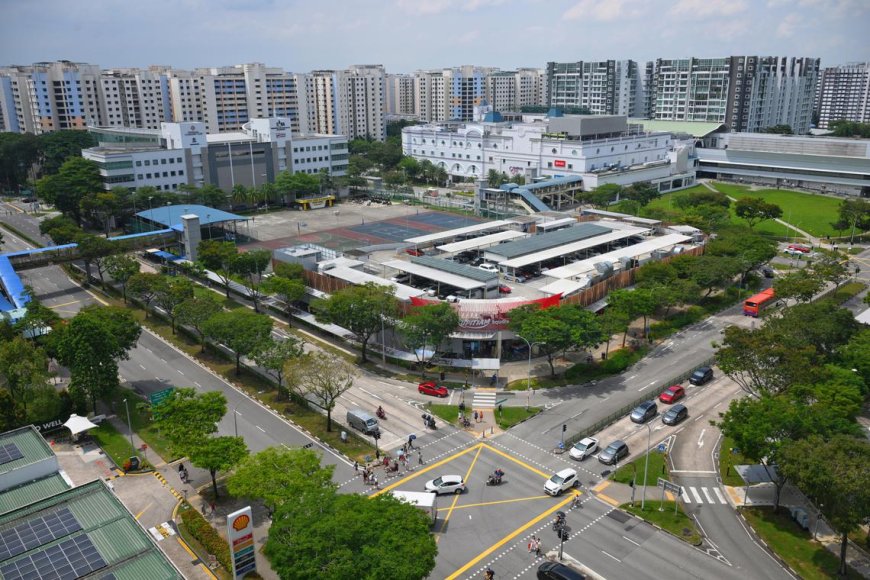New Integrated Community Hubs Planned for Sengkang, Woodlands North, and Yio Chu Kang
Residents of Sengkang, Woodlands North, and Yio Chu Kang can expect new integrated community hubs that will offer recreational facilities and amenities under one roof. Plans for these hubs were revealed at the Urban Redevelopment Authority’s Draft Master Plan 2025 exhibition, along with proposals for new parks and green spaces in the region.

An aerial view on June 21, 2025, showing the existing site in Sengkang that has been earmarked for the upcoming integrated community hub. ST PHOTO: SHINTARO TAY
SINGAPORE – Residents of Sengkang, Woodlands North and Yio Chu Kang can look forward to having recreational facilities and other amenities under one roof at new integrated community hubs proposed for the towns.
Meanwhile, those living in the north-west may get up to four new parks in future as the authorities fine-tune plans for Kranji Nature Corridor, which comprises green spaces and water bodies, as well as roadside greenery that will aid ecological connectivity and increase leisure options.
These plans were laid out at the Urban Redevelopment Authority’s (URA) Draft Master Plan 2025 exhibition, which launched on June 25 at The URA Centre in Maxwell Road.
Among other plans for new recreational facilities are a park in Orchard Road, a new bridge connecting Bay East Garden and Marina Centre in downtown Singapore, as well as a revamped Jurong Hill and Jurong Bird Park.
At the exhibition’s launch, National Development Minister Chee Hong Tat said that the hubs in Sengkang, Woodlands and Yio Chu Kang – to be built in the next 10 to 15 years – will be located near public transport nodes and combine sports facilities, healthcare and community spaces in one location.
An example of an integrated hub is Our Tampines Hub, which houses a regional library, a community club, a football field and a hawker centre, among other amenities.
The Sengkang hub will be located near Compass One mall, while the hub in Woodlands North will be near the upcoming Johor Bahru-Singapore Rapid Transit System Link terminus.
The Yio Chu Kang hub will likely be located on the site of the town’s existing sport centre, which the authorities have plans to redevelop.
As for the parks under study as part of the Kranji Nature Corridor, all four will be near existing water bodies in the area and complement the upcoming 72.8ha Mandai Mangrove and Mudflat Nature Park, which is set to open in 2028.
A planned park by Kranji Reservoir that is about 26ha in size will have waterfront habitats, while a park of about 10ha next to Sungei Pang Sua will incorporate elements of the Keretapi Tanah Melayu railway line that ran in the area.
Two parks will be situated along Sungei Mandai – one in an upcoming residential estate at the former Singapore Racecourse in Kranji, and another farther north that will be about 5ha in size and include mangrove habitats.
Also on display at URA’s exhibition were winning proposals for the Jurong Hill and Jurong Bird Park area that were submitted for an ideas competition launched in October 2024.
The authorities plan to transform the 39ha site into an area for work and play that is integrated with the Jurong Industrial Estate.
The competition drew 10 submissions in the professional category, which was open to those trained in architecture, urban design, urban planning, real estate, environmental planning and related fields, and 27 in the open category, which welcomed submissions from the public and tertiary students.
Topping the professional category was architectural assistant Kenneth Chiang, 29, whose entry featured a central loop connecting research labs, commercial offices and play areas.
One idea in his plan was to house a museum dedicated to Singapore’s industrialisation in Jurong Hill Tower and its surrounds, from where visiting foreign dignitaries once enjoyed panoramic views of the Jurong Industrial Estate.
The winning entry in the open category – by a team of students and fresh graduates who studied urban planning and architecture and who call themselves Bird’s Eye View – proposed that the former Jurong Bird Park’s Waterfall Aviary be repurposed as a wellness facility with pools, saunas and steam rooms.
Meanwhile, in the heart of the city, a new park will be created by combining the existing Istana Park, Dhoby Ghaut Green as well as a 500m stretch of Orchard Road and include a play area inspired by nature.
Pedestrian connectivity between this park and Fort Canning Park will be improved with a new elevated pedestrian bridge.
A pedestrian and cycling bridge will also be built by 2029 near Benjamin Sheares Bridge to link Marina Centre and Bay East Garden, where the Founders’ Memorial is slated to open in 2028.
This bridge will give cyclists a more direct link between the city and East Coast, said URA.
On Singapore’s southern coast, a continuous waterfront promenade will be developed in phases, alongside developments that are part of the Greater Southern Waterfront.
The waterfront promenade will allow users to get from West Coast Park to Marina Bay.
They will pass areas such as a new residential estate at the former Keppel Club, as well as the Keppel Terminal and Keppel Distripark, where new homes will be built under the next phase of the Greater Southern Waterfront’s development.
Ng Keng Gene is a correspondent at The Straits Times, reporting on issues relating to land use, urban planning and heritage.
Join ST's WhatsApp Channel and get the latest news and must-reads.
What's Your Reaction?
 Like
0
Like
0
 Dislike
0
Dislike
0
 Love
0
Love
0
 Funny
0
Funny
0
 Angry
0
Angry
0
 Sad
0
Sad
0
 Wow
0
Wow
0

















































































































































